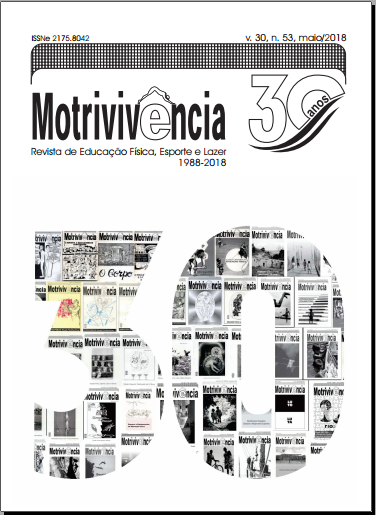Construction how to play rational in Physical Education classes
DOI:
https://doi.org/10.5007/2175-8042.2018v30n53p196Abstract
In this essay we bring main focus is the child who always has great pleasure in “Selfmovement”. The basis for his “Self- movement” is the natural need of the child to play. It turns out that the natural tendency of “ If jogging “ and play the child quickly turns into social and cultural activity by the appropriation of elements of the culture and environment that arise by induction, for the most part , by the imposition of adults accepted activities and recognized by them, finalized pointing Physical Education which often do not allow their own experiences children movement , play and for games of a movement “right “ pregiven and created by third parties, to meet future development undertakings by often one of the most alienating and castrating experiences of freedom and human creativity.
References
ADORNO, T. W. Educação após Auschwitz. In: Educação e Emancipação. 3ª Ed. São Paulo: Paz e Terra. 2003.
AGUIAR, L. Gestalt-terapia com crianças: teoria e prática. São Paulo: Livro Pleno, 2005.
BROUGÈRE, G. Brinquedo e Cultura. 2ª ed. São Paulo: Cortez, 1997.
COSTA, A. R. CRIANÇAS, o que elas querem e precisam do mundo, do adulto e delas mesmas? Dissertação de mestrado apresentada pela UFSC, Florianópolis, 2011.
HEIJ, P. Grondslagen van, verantwoordbewegingsonderwijs - Filosofischeempedagogischedoordenking van relationeelgefundeerdbewegingsonderwijs. Budel: damon 2006. (Tradução para o alemão: Andreas H. Trebels - Tradução para o português: ElenorKunz)
KUNZ, E. Percepção, sensibilidade e intuição para as possibilidades criativas no esporte.In: Stigger, M. P.; Lovisolo, H (Org.). Esporte de Rendimento e Esporte na Escola. Campinas: Autores Associados, 2009.
KUNZ, E. “Brincar e Se-Movimentar” tempos e espaços na vida da criança. Ijuí: UNIJUÌ, 2015.
MATURANA, Humberto. Amar e Brincar: fundamentos esquecidos do humano do patriarcado à democracia. Humberto Maturana e GerdaVerden-Zöller. São Paulo: Palas Athenas, 2004.
OAKLANDER, Violet. Descobrindo Crianças, a abordagem gestáltica com crianças e adolescentes.São Paulo: Summus editorial, 1980.
OAKLANDER, Violet.VerborgeneSchätzeheben: Wege in die innere Welt Von Kindern und Jugendlichen.Stuttgart: Konzepte der Humanwissenschaften, 2009. SARMENTO, M. J. As Culturas da Infância nas Encruzilhadas da 2.ª Modernidade. In M. J. Sarmento e A. B. Cerisara (orgs.). Crianças e Miúdos. Perspectivas Sociopedagógicas da Infância. Porto: ASA, 2004.
TAMBOER, J.W.J. Philosophie der Bewegungswissenschaften.Hannover: Afra, 1994. (tradução livre pelo ProfºElenorKunz)
TONUCCI, F. Quando as crianças dizem: Agora chega! Porto Alegre: Artmed, 2005.
TREBELS, A.H (1983)- Spielen und Bewegen na Gäreten.Reinbekbei Hamburg, rororo, 1983.
ZUR LIPPE, S. SinnenbewuBtsein: GrundlegungeineranthropologischenÄstheitik.Hamburg: rowohltsenzyklopädie, 1987.
Downloads
Published
How to Cite
Issue
Section
License
Os autores dos textos enviados à Motrivivência deverão garantir, em formulário próprio no processo de submissão:
a) serem os únicos titulares dos direitos autorais dos artigos,
b) que não está sendo avaliado por outro(s) periódico(s),
c) e que, caso aprovado, transferem para a revista tais direitos, sem reservas, para publicação no formato on line.
Obs.: para os textos publicados, a revista Motrivivência adota a licença Creative Commons “Atribuição - Não Comercial - Compartilhar Igual 4.0 Internacional” (CC BY-NC-SA).



